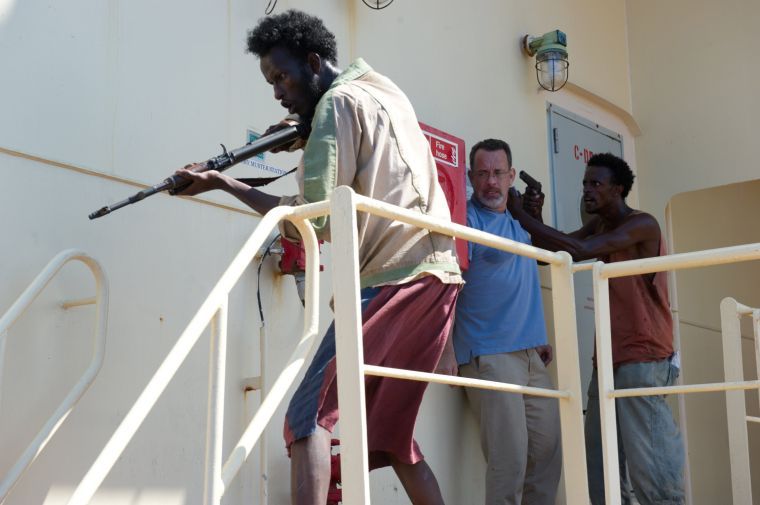‘Captain Phillips’ skillfully retells true tales of piracy
October 16, 2013
“Captain Phillips”
Starring: Tom Hanks, Barkhad Abdi
Directed by: Paul Greengrass
Grade: B+
“Have a safe trip.”
This simple farewell is spoken to loved ones nearly every time they leave on a flight or a trip. It’s what Captain Richard Phillips (Tom Hanks) was told by his wife, Andrea (Catherine Keener) before he embarked on his voyage aboard a cargo ship sailing to Mombasa, Kenya. Little did she know how unsafe his journey would be.
“Captain Phillips” tells the gripping, true story of the Maersk Alabama, a U.S. ship that was hijacked by Somali pirates in April of 2009. More specifically, this film tells the heroic tale of the ship’s captain, Phillips, and his efforts to hinder the attack on his ship and crew.
Tom Hanks portrays Phillips in a masterful performance. He captures the raw emotion of a Captain under pressure to save the lives of not only himself, but his entire crew.
The film was inspired by a book written by the real Richard Phillips titled, “A Captain’s Duty: Somali Pirates, Navy SEALS and Dangerous Days at Sea”, which documents the entire ordeal from the captain’s perspective.
Early on in the film, Phillips is characterized as a family-first man who lives in a small suburban home. This is evident from the coffee mug that has a picture of his wife and kids on it, the fact that he drives a minivan to the airport and how he worries about his children’s grades with his wife.
These images are quickly juxtaposed with shots of life in Somalia. There, teenagers are carrying guns and the only value people have is making the most money possible with no regard for anyone else, according to the film. This is evident by the cruelty seen in the Somalian community, where neighbors push and curse at each other as they all vie for a spot aboard the pirating crew.
Captain Phillips is an unquestionable authority figure. He has complete command over his crew, and deservedly so, as his actions assert that he knows what he is doing. This includes communicating with his superiors during an initial unsuccessful attack by the pirates, alerting them of what is going on and ensuring that he and his crew stay as safe as possible. HE also displays his authority in giving commands to his crew when he anticipates another attack, instructing them to hide in the engine room silently should the pirates successfully board the ship.
This leadership is put to the test when a group of four armed Somali pirates, led by Muse (Barkhad Abdi), board the ship with intentions of stealing all its money and cargo. They are willing to do anything to get it — including kill.
Shouting, violence, intense close-up shots and silence all contribute to the tension-filled scenes aboard the ship, in which Phillips attempts and mostly succeeds in operating smoothly under pressure — all while a gun is held to his back.
Joint efforts from Phillips and some trustworthy crewmembers lead to the capture of Muse, as well as the injuring of another pirate. The Somalis agree to leave on the ship’s lifeboat with $30,000, not a large amount for pirates, since most of the money goes to their long chain of higher-ups, and Muse is to be exchanged with Phillips — captain for captain, hostage for hostage.
Instead, the pirates trick the crew and take Phillips with them on the lifeboat in an effort to get more money as a ransom for the captain. Hanks’ performance reaches a new level while on the lifeboat. He perfectly characterizes the emotions a hostage would feel, including fear, tension, pain and helplessness.
The film does an excellent job of showing the pirates’ desperation while not evoking much, if any, pity from the viewers. The film makes it clear that these Somalis don’t have much choice but to engage in piracy because of their country’s impoverished conditions. Phillips himself notices this desperation when he realizes one of the pirates can’t be older than 16.
Barkhad Abdi’s character embodies the desperate, but mentally and physically tough, lifestyle that extends to all Somalis featured in the film. Abdi’s film debut will certainly not go unnoticed, as his emotional performance is on par with that of Hanks.
The climax of the film is Phillips’ rescue by the U.S. Navy. Shot at sea and at night, the choppy camera, representing the choppiness of the water, the darkness that creates shadows and dim lighting, as well as the images seen through night-vision goggles all add to an intense rescue sequence that will not only make its viewers appreciate the U.S. Armed Forces, but keep them captivated and rooting for Phillips the whole time.
Though the plot of the film is well-known, actually seeing it unfold on the screen is an experience worth seeing, especially for anyone who remembers this event from 2009. Captain Phillips is a true hero, and his story is one that will live on through this film for years to come.



